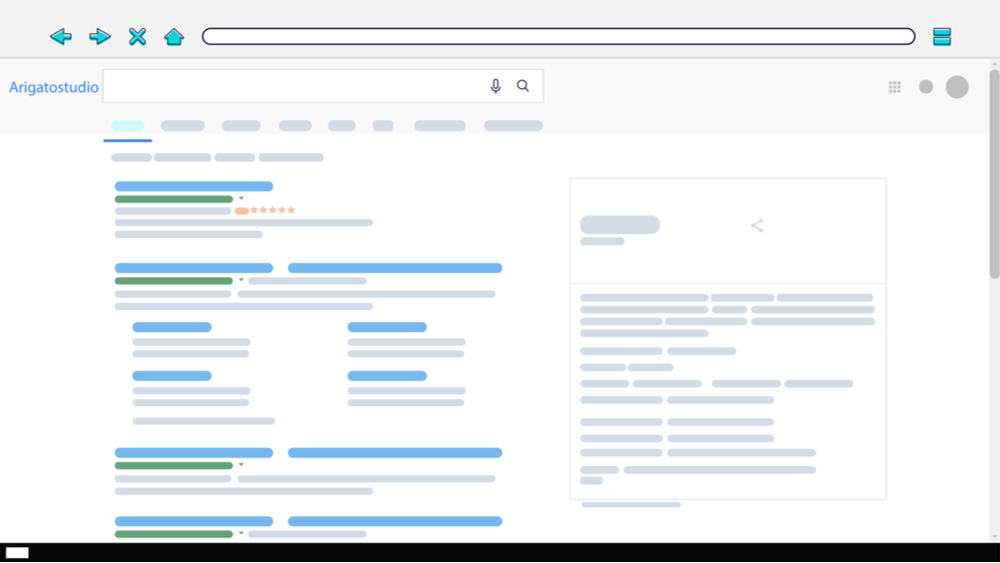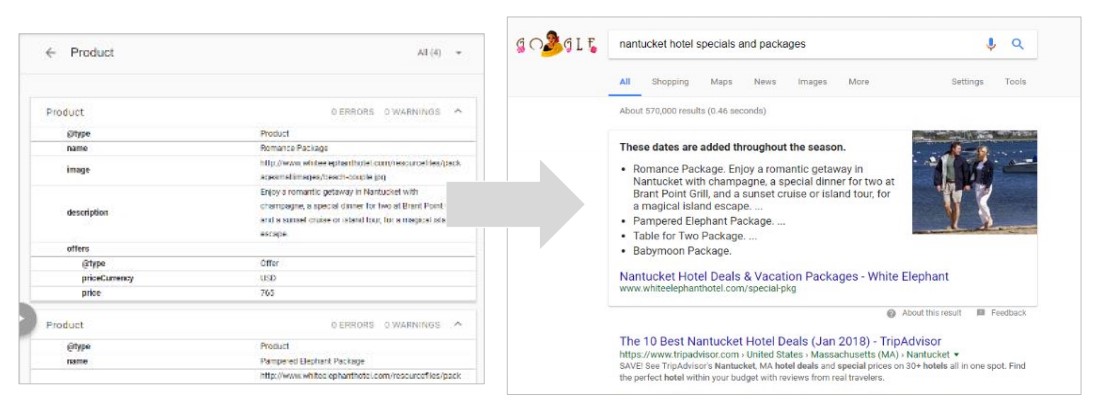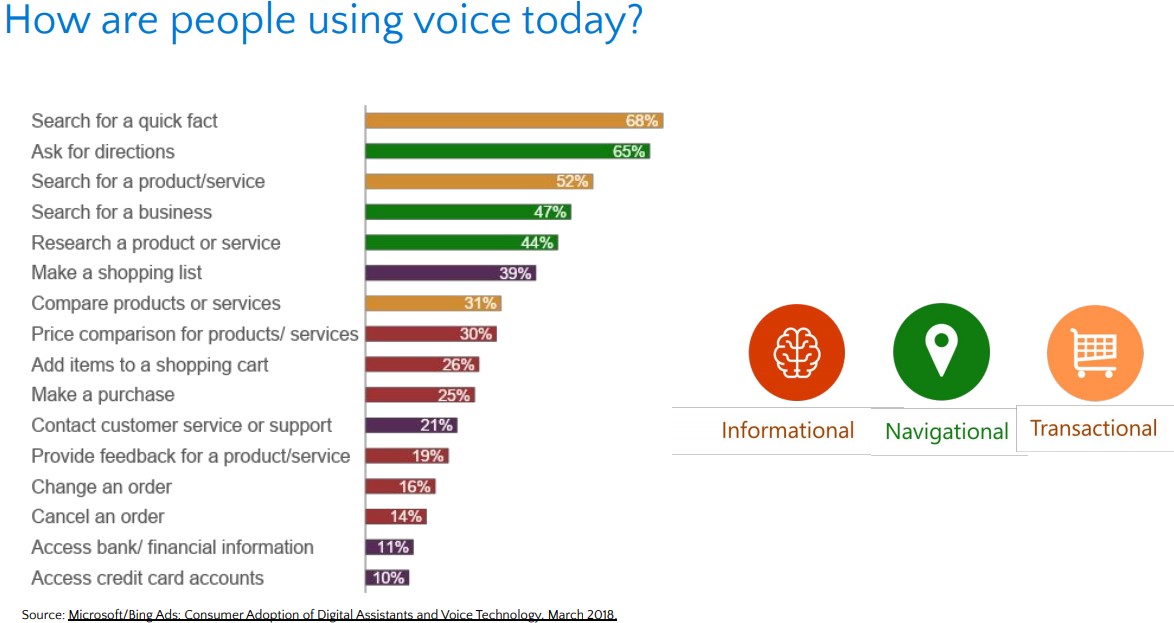The search landscape is ever-changing. Brands and marketers need to catch up and seize the emerging marketing opportunities available today.
Want to know what strategies your business can leverage to be at the forefront of this change?
On July 24, I moderated a sponsored SEJ webinar presented by Milestone’s Michelle Robbins, Christi Olson of Bing, and VMWare’s Punnyatowa Ghosh.
They discussed top search trends, schemas, and how voice search is impacting online opportunities today and beyond.
Here’s a recap of the webinar presentation.

Over the past years, we’ve seen how mobile and screenless devices are changing search and search behavior.
In just the past decade alone, we’ve seen search transform from being text-input-driven and focused on keywords to being voice-driven and focused more on natural language and conversations.
With the growth of mobile usage and the adoption of voice interfaces, the implication for voice search is specifically to deliver the single right answer.
So how do we and our clients become that single right answer?
One of the strongest indicators for getting that prime placement involves schema.
What Is Schema?
Schema is structured data markup that enables search engines to understand the context of your website content. The full spec can be found at the Schema.org site.
The schemas are a set of “types,” each associated with a set of properties. The types are arranged in a hierarchy.
The core vocabulary consists primarily of:
- 614 different types.
- 905 properties.
- 114 enumeration values.
Because there are so many types and properties, you need to understand which can be leveraged with the content you or your client publish.
Schemas have a significant impact on SEO and voice search devices such as Google Home, Cortana, Alexa, and Siri.
Impact of Schemas
For SEO, the impact of schemas is usually in rich snippets, featured snippets, and Position 0 rankings.

Schema organizes and structures information on the website to relate entities to each other (people, places, and things).
You can use a variety of encoding, including RDFa, microdata, and JSON-LD (the most common format).
Testing & Measuring Schema Deployment
When you’re looking to test whether or not you’ve implemented this markup correctly, you can use Google’s Structured Data Testing tool.
The tool will evaluate the markup and raise any errors or warnings that you might have on the page so that you can correct them.
Having error-free markup is critical to ensuring that you’ll get the full benefit of implementing the schemas.
Another important thing to consider is knowing the impact of your schema implementation efforts
To measure the success of a schema deployment, look for:
- Incremental impressions.
- Position movement.
- Incremental organic sessions.
- Incremental organic-driven leads.
- Incremental organic-driven conversions.
Deploying schema requires development resources. It’s not a set-it-and-forget-it tactic.
Case Studies
Large QSR (Fast Food Restaurant) Chain
Here’s a case study for one of Milestone’s clients, a large fast-food restaurant chain.

The schemas were deployed and indexed – showing significant results less than a month actually of being deployed.
The results?
- 33-66% boost in search impressions.
- 60% boost in impressions on unbranded keywords.
- 23% boost in clicks on unbranded keywords.
Top-5 National Bank
Milestone also deployed schemas on a major bank’s Adobe Experience Manager website.
The client saw not just massive growth in impressions in mobile traffic but also online-to-offline growth.
Luxury Jewelry Chain
With schemas deployed for a luxury jewelry chain client, Milestone saw the biggest gains were on mobile devices for both traffic and clicks.
The deployment resulted in 74% more traffic from pages that had schema on them and 30-43% more clicks, depending on the device being utilized.
Luxury Hospitality Group
After deploying schemas to a luxury hospitality group’s website as part of its overall omni-channel plan, the company saw a 30% year-over-year increase in revenue.
Challenges with Schema Deployment
Impressive gains can be achieved with schema implementation, but it isn’t without its challenges.
Some issues include:
- The complexity of schema architecture and knowledge base requires to markup majority of the content.
- Schema.org often revises the schema attributes leading to errors and warnings in current implementations. New schemas are launched frequently.
- Schema deployment in website code requires both IT and SEO technology resources’ involvement on an ongoing basis.
Speakable Schema Markup for Voice Search
With the use of text-to-speech on the rise in mainstream use-case scenarios such as smart speakers (Amazon Echo, Google Home), multimodal interaction on smartphones and in-car systems, there is a need for authors and publishers to be able to easily call out portions of a webpage that are particularly appropriate for reading out aloud.
Currently, the way to do this is by implementing speakable schema.
What Is Speakable Schema?
Speakable schema markup allows you to tell the digital assistants what you want to be said for the content on a page.
Currently available in beta for news articles, marketers should consider deploying speakable schema markup as part of Google News/Bing News.
To deploy this markup, here are a few things to consider:
- Follow Google News/Bing News guidelines via Google News Producer or Publisher Center.
- Speakable markup for text content only. (Not photo captions or source attributions).
- Don’t use Speakable on the entire article. Use it for key points.
- Speakable text should be 2-3 sentences and take no more than 30 seconds to read.
- The story should be broken up into short sentences.
Why Does It Matter?
Even though it’s only available for news publishers at the moment, there is a chance that it might be used by other websites in the future.
AMP (accelerated mobile pages) also started off as just a news-based initiative and then it expanded out beyond the news segment.
Think of this type of schema markup in a similar way.
Even though right now it’s supposed to be used within the news context, after it goes out of beta it will expand to other websites – allowing you to essentially tell the search engines and the digital assistants what you want to be verbalized.
The Implications of Speakable Schema
As you consider implementing speakable schema in the future, it’s going to be really important to think about what is the spoken content that you’d want for a given page.
When people are asking questions about your product to your brand, how would you have it verbally represented?
This means that we have a lot more ways to impact how digital assistants are speaking about our content in the future.
Schema is a signal to the search search engines – meaning search engines are looking at schema and are taken into context for featured snippet, ranks, and answers in Position 0.
But it’s essential to note that schema is not a determining factor and not a requirement to rank.
If you don’t have schema on your pages, it’s not to say that your content would never become a featured snippet – it’s just much more difficult.
Where Do the Digital Assistants Pull Answers From?
If you want to increase your chances of being “the single right answer” for voice searchers, you need to consider where digital assistants pull answers from, namely:
- Featured snippets
- Directory listings
- Knowledge graph/Answer boxes
- Voice actions/chatbots
- Persona/chit-chat responses (You’ll have no control over this.)
Optimizing for Voice Search Is Optimizing for Featured Snippets
There’s a lot of opportunity for optimizing for featured snippets considering that 40% of spoken responses come from featured snippets.
Here are some tips to seize the coveted spot.
- Find queries where you are currently ranking in the top 10.
- Identify questions related to that query.
- Choose how to structure your answer (paragraph, table, list).
- Provide a straightforward answer that adds value.
- Write the answers so it sounds natural when spoken aloud.
- Think about character count – does it fit on a mobile screen?
- Make it easy to find – SEO best practices + Fast Loading Pages + Schema.
Key Voice Search Stats
Microsoft’s 2019 report on Consumer Adoption of Voice Technology and Digital Assistants reveals the following key findings:
- Usage: 69% of respondents have used a digital assistant.
- Adoption: 75% of household will have at least one smart speaker by 2020.
- Trust: 41% of users reported concerns around trust, privacy, and passive listening.
- Functionality: Consumers will not divulge PII (personally identifiable information) without a substantial reward.
- vCommerce (Shopping): Over half of consumers expect their digital assistants to help make retail purchases within the next 5 years.
Search is no longer just 10 blue links on a page. We’re now moving from answers to actions.
Not just voice skills and voice actions (i.e., when you engage with a smart home speaker).
Real actions – as in I want to go, to know, to do, to schedule, arrange, coordinate, etc.
It’s the ability to do something using voice through either a digital assistant or a smart home speaker and users are doing that by asking questions.
Today, people are engaging with voice in a variety of ways.
- 31% are using voice in their car.
- 36% are using it on TV/smart home devices.
- 72% are using personal assistants.
- 35% use smart speakers.
- 52% of those smart speaker users are using voice actions on a regular basis.
This means that if your brand has a voice action or a voice skill, the adoption is starting to come fairly fast. This is another emerging opportunity to tap.
Tips for Optimizing for Different Types of Voice Queries
People are using voice differently and voice queries can be divided into three core categories:
- Informational
- Navigational
- Transactional
 Optimizing for Informational Queries
Optimizing for Informational Queries
- Featured snippet optimization
- Knowledge graph/answer boxes
- Implement schema markup
- Write in a conversational tone/language
- Improve page speed
Optimizing for Navigational Queries
- Own your directory listings
- Publish location-optimized, on-site content
- Get customer reviews
Optimizing for Transactional (vCommerce) Queries
- Create product-specific content
- Implement schema markup (Voice + Product)
- Get customer reviews
- Publish FAQs
- Write in a conversational tone/language
- Create voice action/chatbots
Transactional queries and actions provide the opportunity for voice skills and chatbots to assist the assistants.
Q&A
Here are just some of the attendee questions answered by Michelle Robbins.
Q: What schema was launched most often to produce these positive results?
Michelle Robbins (MR): FAQ schema can be applied to most sites/industries/verticals so that’s a standard recommendation we make across our client base. For other schema types, it really does need to be specific to the page content, however, Event and Product schemas are also high performing types.
Q: You mentioned that Schema is constantly changing and being added to, however, will previously marked content be penalized for old markup?
MR: No. Overall, if there are errors or warnings in your markup, the schema is more likely to be ignored (no benefit from markup).
Q: A lot of this seems really obvious for B2C companies. How well does this really translate for B2B industrial companies?
MR: Our client Vmware is B2B, we showcased their impressive results (as well as our B2C clients’ results) because schema for B2B is non-obvious. But it definitely performs.
Q: How soon will I be able to see results after deploying my schema?
MR: Our clients typically see lift within 4-6 weeks of deployment.
Q: We have been exploring more robust schema markups beyond what the plugins can offer because they do not always offer all the fields we want to highlight. One area is the “productontology” strategy with an additionalType and appending the produntology link with the wikipedia link for the good/service. Have you found success with doing this? Our agency’s problem is that we have a lot of unique clients that simply don’t have a specification on schema.org. I’m always trying to find ways to fit the client’s info/services into schema code.
MR: There are some basic schema types that could be leveraged across the board for websites.
In addition – FAQ content stands out as a “no-brainer” for virtually any company operating a website.
Beyond that, it definitely requires research and a thorough understanding of the schema types available, and utilizing as many as possible related to the main site/page/entity.
And because new types/properties/etc. change frequently, we do not utilize a plugin for our implementations. We have engineering resources dedicated to remaining abreast of changes and opportunities for fast, scalable updates and deployment.
[Video Recap] How Digital Marketers Leverage Schemas to Drive SEO & Voice Search
Watch the video recap of the webinar presentation and Q&A session below.
Or check out the SlideShare below.
Image Credits
All screenshots taken by author, July 2019
Join Us For Our Next Webinar!
Hacks To Earn 1000+ High Authority Links From US Media With Digital PR
Join us as we explore case study examples of data campaigns that have driven hundreds of links from the press. We’ll also be examining how these campaigns were executed to earn authoritative links and mentions, which are critical for SEO.

